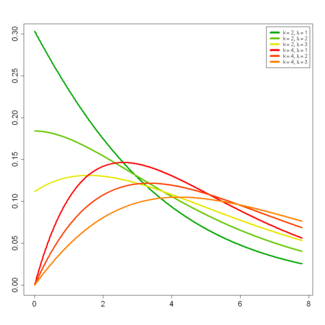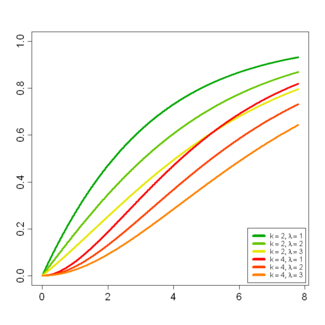- Noncentral chi-squared distribution
-
Noncentral chi-squared Probability density function

Cumulative distribution function

parameters:  degrees of freedom
degrees of freedom
 non-centrality parameter
non-centrality parametersupport: 
pdf: 
cdf:  with Marcum Q-function QM(a,b)
with Marcum Q-function QM(a,b)mean: 
variance: 
skewness: 
ex.kurtosis: 
mgf:  for 2t < 1
for 2t < 1cf: 
In probability theory and statistics, the noncentral chi-squared or noncentral χ2 distribution is a generalization of the chi-squared distribution. This distribution often arises in the power analysis of statistical tests in which the null distribution is (perhaps asymptotically) a chi-squared distribution; important examples of such tests are the likelihood ratio tests.
Contents
Background
Let Xi be k independent, normally distributed random variables with means μi and variances
 . Then the random variable
. Then the random variableis distributed according to the noncentral chi-squared distribution. It has two parameters: k which specifies the number of degrees of freedom (i.e. the number of Xi), and λ which is related to the mean of the random variables Xi by:
λ is sometime called the noncentrality parameter. Note that some references define λ in other ways, such as half of the above sum, or its square root.
This distribution arises in multivariate statistics as a derivative of the multivariate normal distribution. While the central chi-squared distribution is the squared norm of a random vector with N(0k,Ik) distribution (i.e., the squared distance from the origin of a point taken at random from that distribution), the non-central χ2 is the squared norm of a random vector with N(μ,Ik) distribution. Here 0k is a zero vector of length k, μ = (μ1,...,μk) and Ik is the identity matrix of size k.
Properties
Probability density function
The probability density function is given by
where Yq is distributed as chi-squared with q degrees of freedom.
From this representation, the noncentral chi-squared distribution is seen to be a Poisson-weighted mixture of central chi-squared distributions. Suppose that a random variable J has a Poisson distribution with mean λ / 2, and the conditional distribution of Z given J = i is chi-squared with k+2i degrees of freedom. Then the unconditional distribution of Z is non-central chi-squared with k degrees of freedom, and non-centrality parameter λ.
Alternatively, the pdf can be written as
where Iν(z) is a modified Bessel function of the first kind given by
Using the relation between Bessel functions and hypergeometric functions, the pdf can also be written as:[1]
Siegel (1979) discusses the case k=0 specifically (zero degrees of freedom), in which case the distribution has a discrete component at zero.
Moment generating function
The moment generating function is given by
The first few raw moments are:
The first few central moments are:
The nth cumulant is
Hence
Cumulative distribution function
Again using the relation between the central and noncentral chi-squared distributions, the cumulative distribution function (cdf) can be written as
where
 is the cumulative distribution function of the central chi-squared distribution which is given by
is the cumulative distribution function of the central chi-squared distribution which is given by- and where
 is the lower incomplete Gamma function.
is the lower incomplete Gamma function.
The Marcum Q-function QM(a,b)can also be used to represent the cdf.[2]
Approximation
Sankaran [3] discusses a number of closed form approximations for the cumulative distribution function. In an earlier paper,[4] he derived and states the following approximation:
where
 denotes the cumulative distribution function of the standard normal distribution;
denotes the cumulative distribution function of the standard normal distribution;


This and other approximations are discussed in a later text book.[5]
To approximate the Chi-squared distribution, the non-centrality parameter,
 , is set to zero.
, is set to zero.For a given probability, the formula is easily inverted to provide the corresponding approximation for
 .
.Derivation of the pdf
The derivation of the probability density function is most easily done by performing the following steps:
- First, assume without loss of generality that
 . Then the joint distribution of
. Then the joint distribution of  is spherically symmetric, up to a location shift.
is spherically symmetric, up to a location shift. - The spherical symmetry then implies that the distribution of
 depends on the means only through the squared length,
depends on the means only through the squared length,  . Without loss of generality, we can therefore take
. Without loss of generality, we can therefore take  and
and  .
. - Now derive the density of
 (i.e. k=1 case). Simple transformation of random variables shows that :
(i.e. k=1 case). Simple transformation of random variables shows that :
where is the standard normal density.
is the standard normal density. - Expand the cosh term in a Taylor series. This gives the Poisson-weighted mixture representation of the density, still for k=1. The indices on the chi-squared random variables in the series above are 1+2i in this case.
- Finally, for the general case. We've assumed, without loss of generality, that
 are standard normal, and so
are standard normal, and so  has a central chi-squared distribution with (k-1) degrees of freedom, independent of
has a central chi-squared distribution with (k-1) degrees of freedom, independent of  . Using the poisson-weighted mixture representation for
. Using the poisson-weighted mixture representation for  , and the fact that the sum of chi-squared random variables is also chi-squared, completes the result. The indices in the series are (1+2i)+(k-1) = k+2i as required.
, and the fact that the sum of chi-squared random variables is also chi-squared, completes the result. The indices in the series are (1+2i)+(k-1) = k+2i as required.
Related distributions
- If V is chi-squared distributed
 then V is also non-central chi-squared distributed:
then V is also non-central chi-squared distributed: 
- If
 and
and  and V1 is independent of V2 then a noncentral F-distributed variable is developed as
and V1 is independent of V2 then a noncentral F-distributed variable is developed as 
- If
 , then
, then 
- Normal approximation[6]: if
 , then
, then  in distribution as either
in distribution as either  or
or  .
.
Transformations
Sankaran (1963) discusses the transformations of the form z = [(X − b) / (k + λ)]1 / 2. He analyzes the expansions of the cumulants of z up to the term O((k + λ) − 4) and shows that the following choices of b produce reasonable results:
- b = (k − 1) / 2 makes the second cumulant of z approximately independent of λ
- b = (k − 1) / 3 makes the third cumulant of z approximately independent of λ
- b = (k − 1) / 4 makes the fourth cumulant of z approximately independent of λ
Also, a simpler transformation z1 = (X − (k − 1) / 2)1 / 2 can be used as a variance stabilizing transformation that produces a random variable with mean (λ + (k − 1) / 2)1 / 2 and variance O((k + λ) − 2).
Usability of these transformations may be hampered by the need to take the square roots of negative numbers.
Various chi and chi-squared distributions Name Statistic chi-squared distribution 
noncentral chi-squared distribution 
chi distribution 
noncentral chi distribution 
Notes
- ^ Muirhead (2005) Theorem 1.3.4
- ^ Nuttall, Albert H. (1975): Some Integrals Involving the QM Function, IEEE Transactions on Information Theory, 21(1), 95-96, ISSN 0018-9448
- ^ Sankaran , M. (1963). Approximations to the non-central chi-squared distribution Biometrika, 50(1-2), 199–204
- ^ Sankaran , M. (1959). "On the non-central chi-squared distribution", Biometrika 46, 235–237
- ^ Johnson et al. (1995) Section 29.8
- ^ Muirhead (2005) pages 22–24 and problem 1.18.
References
- Abramowitz, M. and Stegun, I.A. (1972), Handbook of Mathematical Functions, Dover. Section 26.4.25.
- Johnson, N. L., Kotz, S., Balakrishnan, N. (1970), Continuous Univariate Distributions, Volume 2, Wiley. ISBN 0-471-58494-0
- Muirhead, R. (2005) Aspects of Multivariate Statistical Theory, Wiley
- Siegel, A.F. (1979), "The noncentral chi-squared distribution with zero degrees of freedom and testing for uniformity", Biometrika, 66, 381–386
- Press, S.J. (1966), "Linear combinations of non-central chi-squared variates", The Annals of Mathematical Statistics 37 (2): 480–487, JSTOR 2238621
Categories:- Continuous distributions
Wikimedia Foundation. 2010.




















